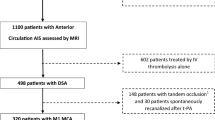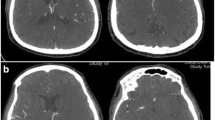Abstract
Purpose
There are few data on the prevalence and impact of isolated deep grey matter infarction in acute stroke. In this study, we aimed to investigate the prevalence of isolated deep grey matter infarcts and their impact on the outcome.
Methods
Infarcts on 24-h follow-up imaging (non-contrast head CT or diffusion-weighted MRI) in the ESCAPE-NA1 trial were categorized into predominantly deep grey matter infarcts vs. infarcts involving additional territories (“other infarcts”). Total infarct volume was manually segmented. Baseline characteristics and proportions of good outcome (primary outcome, defined as modified Rankin Score [mRS] 0–2 at 90 days), excellent outcome (mRS 0–1) and mortality were compared between patients with and without predominantly deep grey matter infarcts. Multivariable logistic regression with adjustment for baseline variables and total infarct volume was used to determine a possible association of predominantly deep grey matter infarcts and clinical outcome.
Results
Predominantly deep grey matter infarcts were seen in 316/1026 patients (30.8%). Compared to other patients, their ASPECTS was higher, collateral status and reperfusion quality were better and time to treatment was shorter. Good outcome was seen in 239/316 (75.6%) with vs. 374/704 (53.1%) without predominantly deep grey matter infarcts. After adjusting for baseline variables and total infarct volume, predominantly deep grey matter infarcts were independently associated with excellent outcome (adjOR: 1.45 [CI95: 1.04–2.02]), but not with good outcome (adjOR: 1.24 [CI95: 0.86–1.80]) or mortality (adjOR: 0.73 [CI95:0.39–1.35])
Conclusion
Predominantly deep grey matter infarct patterns were seen in 1/3rd of patients and were significantly associated with increased chances of excellent outcome, independent of patient baseline status and infarct size.



Similar content being viewed by others
Abbreviations
- adjOR:
-
Adjusted odds ratio
- ASPECTS:
-
Alberta Stroke Program Early CT Score
- CI95 :
-
95% confidence interval
- DWI:
-
Diffusion-weighted imaging
- eTICI:
-
Expanded Thrombolysis in Cerebral Infarction Score
- EVT:
-
Endovascular treatment
- IQR:
-
Interquartile range
- LVO:
-
Large vessel occlusion
- NCCT:
-
Non-contrast head CT
References
Horie N, Morofuji Y, Iki Y, Sadakata E, Kanamoto T, Tateishi Y, Izumo T, Anda T, Morikawa M, Tsujino A, Matsuo T (2019) Impact of basal ganglia damage after successful endovascular recanalization for acute ischemic stroke involving lenticulostriate arteries. J Neurosurg 132:1–9. https://doi.org/10.3171/2019.3.JNS182909
Kaesmacher J, Maegerlein C, Kaesmacher M, Zimmer C, Poppert H, Friedrich B, Boeckh-Behrens T, Kleine JF (2017) Thrombus migration in the middle cerebral artery: incidence, imaging signs, and impact on success of endovascular thrombectomy. J Am Heart Assoc 6(2). https://doi.org/10.1161/JAHA.116.005149
Hill MD, Goyal M, Menon BK, Nogueira RG, McTaggart RA, Demchuk AM, Poppe AY, Buck BH, Field TS, Dowlatshahi D, van Adel BA, Swartz RH, Shah RA, Sauvageau E, Zerna C, Ospel JM, Joshi M, Almekhlafi MA, Ryckborst KJ, Lowerison MW, Heard K, Garman D, Haussen D, Cutting SM, Coutts SB, Roy D, Rempel JL, Rohr AC, Iancu D, Sahlas DJ, Yu AYX, Devlin TG, Hanel RA, Puetz V, Silver FL, Campbell BCV, Chapot R, Teitelbaum J, Mandzia JL, Kleinig TJ, Turkel-Parrella D, Heck D, Kelly ME, Bharatha A, Bang OY, Jadhav A, Gupta R, Frei DF, Tarpley JW, McDougall CG, Holmin S, Rha JH, Puri AS, Camden MC, Thomalla G, Choe H, Phillips SJ, Schindler JL, Thornton J, Nagel S, Heo JH, Sohn SI, Psychogios MN, Budzik RF, Starkman S, Martin CO, Burns PA, Murphy S, Lopez GA, English J, Tymianski M, Investigators E-N (2020) Efficacy and safety of nerinetide for the treatment of acute ischaemic stroke (ESCAPE-NA1): a multicentre, double-blind, randomised controlled trial. Lancet 395(10227):878–887. https://doi.org/10.1016/S0140-6736(20)30258-0
Russmann H, Vingerhoets F, Ghika J, Maeder P, Bogousslavsky J (2003) Acute infarction limited to the lenticular nucleus: clinical, etiologic, and topographic features. Arch Neurol 60(3):351–355. https://doi.org/10.1001/archneur.60.3.351
Miyai I, Blau AD, Reding MJ, Volpe BT (1997) Patients with stroke confined to basal ganglia have diminished response to rehabilitation efforts. Neurology 48(1):95–101. https://doi.org/10.1212/wnl.48.1.95
Gold G, Kovari E, Herrmann FR, Canuto A, Hof PR, Michel JP, Bouras C, Giannakopoulos P (2005) Cognitive consequences of thalamic, basal ganglia, and deep white matter lacunes in brain aging and dementia. Stroke 36(6):1184–1188. https://doi.org/10.1161/01.STR.0000166052.89772.b5
Zhu H, Wang W, Li H, Chen K, Li P, Li X, Zhang J, Wei D, Chen Y (2019) Basal ganglia-cortical circuit disruption in subcortical silent lacunar infarcts. Front Neurol 10:660. https://doi.org/10.3389/fneur.2019.00660
Acknowledgements
The ESCAPE-NA1 sites.
Funding
The authors report no funding for this manuscript. The ESCAPE-NA1 trial was funded by the Canadian Institutes for Health Research, Alberta Innovates, NoNo Inc.
Author information
Authors and Affiliations
Consortia
Corresponding author
Ethics declarations
Ethical approval
This study was approved by the local ethics board of all participating sites.
Conflict of interest
BM: patent (stroke triage systems), stock ownership (Circle Neurovascular). MG: consultant (Medtronic, Stryker, Microvention, GE Healthcare, Mentice). MDH: grants (CIHR, Medtronic, NoNo Inc.) outside the submitted work, patent (US Patent office Number:62/086,077), boards: Circle Neurovascular, Canadian Neuroscience Federation, Canadian Stroke Consortium. Dr. Nogueira reports personal fees and other from Stryker Neurovascular, personal fees and other from Medtronic, other from Penumbra, personal fees and other from Cerenovus/ Neuravi, personal fees and other from Phenox, personal fees from Anaconda, personal fees from Genentech, personal fees from Biogen, personal fees from Prolong Pharmaceuticals, personal fees from Brainomix, personal fees from Viz-AI, personal fees from Corindus Vascular Robotics, personal fees from Vesalio, personal fees from Ceretrieve, outside the submitted work. Dr. Demchuk reports grants from NoNO Inc, during the conduct of the study; In addition, Dr. Demchuk has a patent Circle NVI issued and Medtronic honoraria for CME events. Dr. Bharatha reports personal fees from Medtronic, outside the submitted work. Dr. Tymianski reports other from NoNO Inc., during the conduct of the study; In addition, Dr. Tymianski has a patent 7,595,297 issued, a patent 10,064,910 issued, and a patent 8,940,699 issued. Remaining authors: none.
Informed consent
Informed consent was obtained from all participants prior to enrolment.
Additional information
Publisher’s note
Springer Nature remains neutral with regard to jurisdictional claims in published maps and institutional affiliations.
Rights and permissions
About this article
Cite this article
Ospel, J., Mayank, A., Qiu, W. et al. Clinical outcomes of isolated deep grey matter infarcts after endovascular treatment of large vessel occlusion stroke. Neuroradiology 63, 1463–1469 (2021). https://doi.org/10.1007/s00234-021-02656-4
Received:
Accepted:
Published:
Issue Date:
DOI: https://doi.org/10.1007/s00234-021-02656-4




